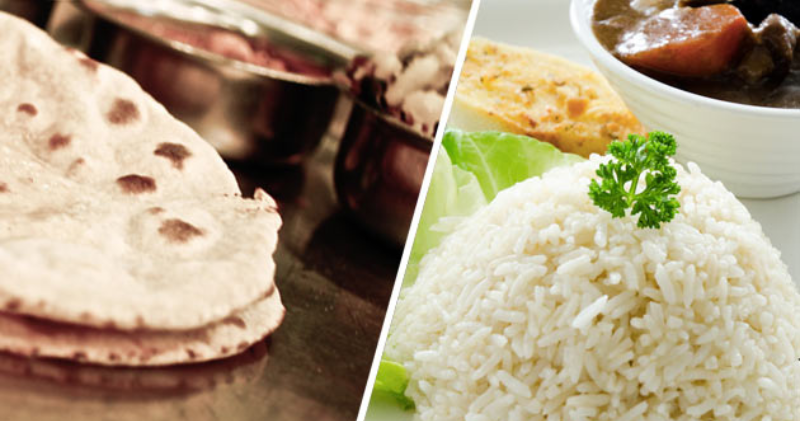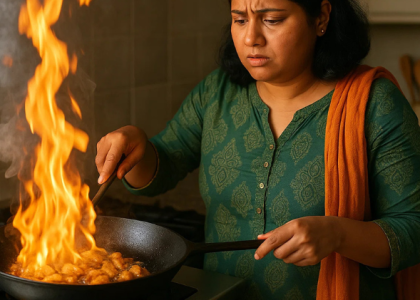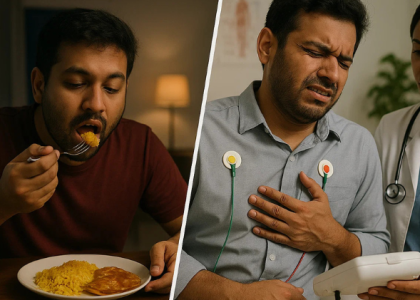When Everyday Foods Become Heart Risks
Rice and roti are the backbone of most Indian meals. They have been part of our diet for generations. But today, these simple staples might be affecting our heart health more than we realize.
What’s Changed?
Our grandparents ate rice and roti too. So what’s different now?
Portion sizes have grown. Look at your thali today compared to 30 years ago. Our rice portions have often doubled or tripled. Where a small katori of rice was once standard, many of us now fill half our plate with rice [1].
Our activity levels have dropped. Our grandparents walked more, did more physical work, and burned more calories. Many of us now sit at desks all day.
The processing has increased. White rice today is more polished than ever before, removing almost all the fiber and nutrients.
Why White Rice Affects Your Heart
When you eat white rice, your body quickly breaks it down into sugar. This causes a rapid spike in your blood sugar levels [2].
These spikes, especially when they happen daily with large portions, can lead to:
- Insulin resistance
- Higher triglyceride levels (a type of fat in your blood)
- Increased risk of type 2 diabetes (which is linked to heart disease)
- Weight gain around the middle (which puts pressure on your heart)
Think about Sharma Uncle who eats two large bowls of rice every dinner. His blood sugar goes up and down like a roller coaster every day. Over time, this is harmful to his heart.
The Wheat Problem
Many people think rotis are always healthier than rice. But the refined wheat flour (maida) in many store-bought rotis and naans can cause the same problems as white rice.
Even homemade rotis, when eaten in large quantities, can lead to blood sugar spikes. Many of us eat 3-4 rotis per meal, which is a lot of refined carbohydrates for our body to handle.
Portion Control: The First Step
You don’t need to give up rice and rotis completely. Start with controlling portions:
- Limit rice to a small katori (about ½ cup cooked)
- Stick to 1-2 rotis per meal
- Fill half your plate with vegetables instead
Rani Aunty made a simple change – she now uses a smaller serving spoon for rice and limits herself to one serving. Within three months, her doctor noticed improvements in her blood sugar levels.
Better Alternatives to Try
For rice lovers:
- Brown rice has more fiber and nutrients than white rice
- Red rice is rich in antioxidants
- Black rice (forbidden rice) is highest in protein and antioxidants
- Try cauliflower rice for a low-carb option
For roti lovers:
- Add millet flour to your wheat flour (try 1:3 ratio)
- Make jowar (sorghum) rotis
- Try ragi (finger millet) rotis which are excellent for heart health
- Bajra (pearl millet) rotis are especially good in winter
Add Fiber to Slow Digestion
The key is adding fiber to slow down digestion and prevent blood sugar spikes.
Simple ways to add fiber:
- Add vegetables to your rice (mix peas, carrots, or spinach into pulao)
- Eat dal or yogurt with your rice
- Include a salad with every meal
- Start your meal with vegetables before moving to rice or roti
Real-Life Swaps That Work
Meena, a working mother in Mumbai, made these changes to her family’s meals:
- Monday: Mixed brown rice with white rice (starting 20:80, gradually increasing brown rice)
- Tuesday: Replaced one roti with a small bowl of vegetable soup
- Wednesday: Made millets idli instead of rice idli
- Thursday: Added grated vegetables to her roti dough
- Friday: Made ragi dosa instead of rice dosa
Her family hardly noticed the changes, but her husband’s doctor was impressed with his improved cholesterol levels after six months.
Remember:
Small changes add up. You don’t need to completely change your diet overnight. Start with one meal a day, or even one meal a week. Your heart will thank you for every small improvement.
Eating less white rice and refined wheat isn’t about giving up your favorite foods—it’s about making room for more variety and nutrition in your diet.




